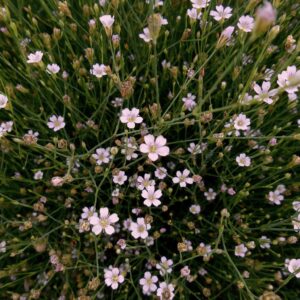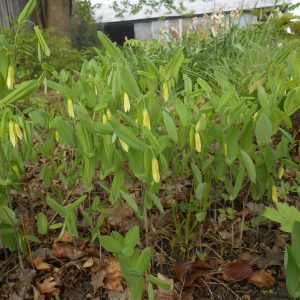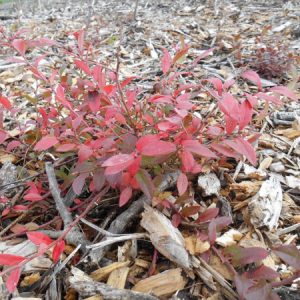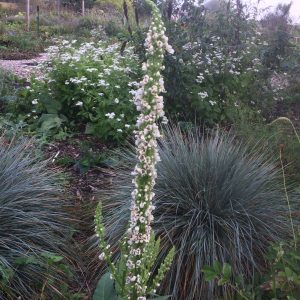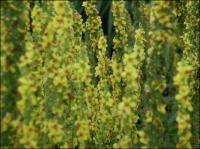Shop
Showing 745–752 of 778 results
-
Tunica saxifraga syn. Petrorhagia saxifraga Tunic flower Z 4-8
Free blooming pixie, palest of pink blossoms from June through October on wiry stems form a 4" tall mound.
Free blooming pixie, palest of pink blossoms from June through October on wiry stems form a 4″ tall mound.
Size: 6" x 8"
Care: Full sun in well-drained soil.
Native: Pyrenees and Alps
Wildlife Value: Drought tolerant.
Awards: Royan Horticultural Society Award of Merit.
Size: Perfect for rock gardens, front of borders or groundcover.Tunica is Latin meaning tunic or coat referring to overlapping bracts beneath the flower. Before 1753. Near the turn of the century William Robinson described the Tunic flower as having “elegant little rosy flowers … a neat plant for the rock garden and fringes of borders and thrives like a weed between the stones in a rough stone wall.” “Suggestive of a miniature gypsophila.” H.H. Thomas, 1915.
-
Uvularia grandiflora Largeflower bellwort, Fairybells Z 4-9
Graceful, hanging pale yellow bells, like a gypsy’s skirt, in spring
ARCHIVED
Note: This is a plant not currently for sale. This is an archive page preserved for informational use.
Graceful, hanging pale yellow bells, like a gypsy’s skirt, in spring
Size: 10-20” x 6” spread slowly
Care: part shade to shade in moist to moist well-drained soil
Native: Quebec to Ontario, NH to ND, Louisiana to Georgia, Wisconsin native
Wildlife Value: Attracts bees
Awards: Royal Horticultural Society Award of MeritMenominee reduced swelling with this plant. Ojibwa cured stomach pains and Potawatomi mixed it with lard to cure sore muscles & backaches. Collected for gardens by 1802. Wm. Robinson considered this a “graceful perennial … the finest of the species.”
-
Uvularia sessilifolia Merrybells Z 4-8
Elongated cream colored bells dangle under lily-like leaves in April-May
ARCHIVED
Note: This is a plant not currently for sale. This is an archive page preserved for informational use.
Elongated cream colored bells dangle under lily-like leaves in April-May
Size: 6-10” X 8”
Care: Sun to shade in moist, well-drained acidic soil
Native: Eastern & central North America, Wisconsin native.
Wildlife Value: attracts bees & other pollinatorsGrown at Elgin Botanic Garden, America’s 1st botanic garden, 1811. Cherokee made a tea from the roots to treat diarrhea; made a poultice for boils and cooked and ate the leaves. Iroquois made a tea from roots to purify blood and a poultice to mend broken bones. It is taken internally to aid in healing broken bones. Ojibwa used root in hunting to bring deer closer. Collected before 1753.
-
Vaccinium angustifolium Lowbush Blueberry Z 2-6
Urn-shaped white flowers in May and June turn to glossy blue berries. Foliage turns fiery red in fall. This is the true native bearing small, intensely flavored blueberries.
OUT OF STOCK
Note: This is a plant not currently for sale. This is an archive page preserved for informational use.Urn-shaped white flowers in May & June turn to glossy blue berries. Foliage turns fiery red in fall. The true native, bearing small, intensely flavored blueberries.
Size: 2-12” x 3’ spreading by runners
Care: sun to part shade in moist well-drained, very acidic soil. Mulch, roots shallow & wide spreading.
Native: entire NE of No. America as far west as Minnesota & South to N. Carolina, Wisconsin native.
Wildlife Value: nectar source for butterflies esp. Zebra swallowtail Food source for moth caterpillars, terrestrial turtles, numerous birds (Turkey, Blue Jay, Bluebird, Wood thrush & Robin) and numerous mammals. Deer & rabbits like the branches & leaves. Habitat for ground nesting birds.
Awards: Cary Award Distinctive Plants for New EnglandDescribed in literature, 1789. Many Native Americans ate the berries (fresh or dried) or mixed berries with other ingredients for food: Algonquin, Iroquois, Ojibwa & Menominee. A few ate the flowers. Algonquin made medicine from the leaves and roots for colic, miscarriages & inducing labor. Ojibwa put dried flowers on hot stones to inhale the fumes for “craziness.” stated that the fruit, leaves, and root bark were useful in the treatment of mouth sores, diarrhea, and other bowel complaints. Winnebago dried the berries to and added them to flavor medicine including stimulate appetite https://nativeplants.ku.edu/wp-content/uploads/2010/05/Kindscher-1998-Huron-Smiths-Ethnobotany.pdf Rafinesque (1828-1830) discussed this taxon as a diarrhea cure. Berries were formerly rendered into a syrup-like beverage that was consumed for chronic dysentery. The leaves and root bark were made into a tea that was administered as a treatment forsore throats and diarrhea (Angier 1978; Krochmal and Krochmal 1973).”
-
Vaccinium macrocarpon syn. Oxycoccus macrocarpus Cranberry Z 3-7 Evergreen shrub
Clusters of nodding clusters of pink tube-shaped flowers in spring grow into large cranberries in September-October.
OUT OF STOCK
Clusters of nodding clusters of pink tube-shaped flowers in spring grow into large cranberries in September-October.
Size: 8-10" x 2-3'
Care: sun in moist well-drained acidic soil
Native: Northern east coast to northern central US & Canada, Wisconsin native
Wildlife Value: attracts bees, butterflies, and birds for nectar; small animals eat the fruits and nest in it“An easy to grow and beautiful ornamental …will thrive in moist soil. A bog is not necessary… The evergreen plants make dense 8” to 10” high mats of tiny leaves (that) bear little pinkish flowers in late spring, and in the fall the leaves turn as fiery red as the berries.” 25 sq ‘+ 5 lbs berries. Cuttings easily root. Plant 1 per sq. ft. Described by Aiton. Algonquin, Chippewa, Iroquois, Ojibwa ate the berries.
-
Vaccinium vitis-idaea Lingonberry, Mountain cranberry, Cowberry, Foxberry Z 2-7
Evergreen foliage on this shrub, In spring down facing, pink urn-shaped flowers bloom. Then in late summer bright red berries appear and persist into winter. Spreads to form colony.
OUT OF STOCK
Evergreen foliage on this shrub, In spring down facing, pink urn-shaped flowers bloom. Then in late summer bright red berries appear and persist into winter. Spreads to form colony.
Size: 6-12” x 3’ spreading
Care: sun to part shade in moist, very acidic soil
Native: Boreal forest and Arctic tundra in Northern Hemisphere from Eurasia to North America, Wisconsin native.
Size: Often made into jam, juice, syrup and relish. The berries contain high amounts of vitamin C, A and B1, B2, B3, as well as phytochemicals and omega-3 fatty acids. Historically used in folk medicine as an astringent, antihemorrhagic, anti-debilitive, depurative, antiseptic, diuretic, tonic for the nervous system, as well as treatment for breast cancer, diabetes, rheumatism, infections, gastrointestinal tract, kidneys, urinary tract ailments and fever.In 1745 Russian Empress Elizabeth ordered lingonberry planted all over grounds at Peterhof Palace in St. Petersburg. The common name Lingonberry comes from the Norse word for heather, lyngr. Vitis- idaea comes from vitis which is Latin for vine and idaea meaning “from Mount Ida.” According to L.H. Bailey, “Throughout the whole of N. Canada, hunters and trappers, as well as the native Indians, frequently depend on it for food. It is valuable for the shrubbery border, where the strong contrast of the dark green foliage and the bright colored persistent fruit is very striking.”
-
Verbascum chaixii Nettleleaved mullein Z 5-8
Spikes covered in white flowers with pink eyes from mid to late summer
ARCHIVED
Note: This is a plant not currently for sale. This is an archive page preserved for informational use.
Spikes covered in white flowers with pink eyes from mid to late summer
Size: 36” x 18”
Care: Full sun in well drained, poor soil
Native: EuropeVerbascum was named by the Roman Pliny who said they attracted moths, calling them Moth mulleins. Described by Parkinson in 1629: “a stalk, the flowers hereof are pure white with the like purple threads in the middle.”
-
Verbascum nigrum Dark mullein Z 4-9
June to October (if deadheaded) canary yellow, occasionally ivory, spikes with purple stamens.
June to October (if deadheaded) canary yellow, occasionally ivory, spikes with purple stamens.
Size: 36" x 24"
Care: Sun in moist well-drained to well-drained soil - self-seeder. Drought tolerant.
Native: Europe to SiberiaVerbascum was named by the Roman Pliny who said they attracted moths, calling them Moth mulleins. Cultivated in gardens as long ago as Medieval times. Favorite plant in Elizabethan cottage gardens in the 1500’s. Grown in the Eichstätt Garden, the garden of Johann Konrad von Gemmingen, prince bishop of Eichstätt in Bavaria, c. 1600. Described by Parkinson in 1629 as: “a stalke whereon stand many golden flowers with the like purple threads in the middle.”

